8-1: Training in Organizations
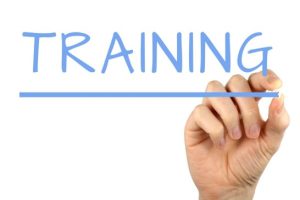 You walk into your new job on day one, confident and ready to make an impact. Then reality hits. The software is different from what you used in school, the company has its own unique processes, and everyone seems to speak in acronyms you’ve never heard before. Sound familiar? Don’t worry – you’re not alone, and this is exactly why organizations invest a staggering $126 billion annually on employee learning and development according to the American Society for Training and Development.
You walk into your new job on day one, confident and ready to make an impact. Then reality hits. The software is different from what you used in school, the company has its own unique processes, and everyone seems to speak in acronyms you’ve never heard before. Sound familiar? Don’t worry – you’re not alone, and this is exactly why organizations invest a staggering $126 billion annually on employee learning and development according to the American Society for Training and Development.
Here’s the thing: even if you aced every interview and have an impressive resume, you’re probably not going to be immediately ready to perform at optimal levels in your new role. That’s not a reflection on you – it’s just the reality of how work works. And that’s where training comes in.
Training encompasses any kind of formal teaching that relates to job responsibilities and organizational goals. More precisely, it refers to the formal procedures that companies use to help employees learn so that their performance contributes to achieving organizational goals and objectives. Think of it as your professional GPS – it helps you navigate from where you are to where you need to be.
Get this: over 90% of Fortune 500 companies maintain formal training programs, with average training budgets for top-tier organizations reaching $30.6 million annually. These aren’t just feel-good expenses – they’re strategic investments. Even the most sophisticated hiring processes can’t identify candidates who possess all the knowledge, skills, and abilities (KSAs) required for immediate job success.
Why Organizations Need Training
Let’s be honest – the world of work is changing faster than ever. Remember when knowing Microsoft Word was cutting-edge? Now we’re talking about AI, blockchain, and technologies that didn’t exist five years ago. The changing nature of work requires constant updating of knowledge and skills, particularly in technology-driven fields where yesterday’s knowledge may become obsolete today.
But training isn’t just about keeping up with technology. Research consistently demonstrates that well-designed training programs reduce absenteeism and turnover while enhancing job satisfaction and organizational loyalty. It’s a win-win: you get better at your job, and you feel more valued by your employer.
Arthur, Bennett, Edens, and Bell (2003) found through meta-analysis that training effectiveness varies significantly based on training design and delivery methods, with skills-based training showing stronger effects on performance than cognitive ability training. In other words, hands-on learning tends to stick better than just memorizing facts.
The key here is that training content should come directly from KSAs identified through comprehensive job analysis. This ensures that training efforts focus on job-relevant competencies while providing legal defensibility for training investments and decisions. You want to learn skills that actually matter for your role, not just generic content.
Goldstein and Ford’s Training Model
Now, let’s talk about how effective training actually happens. Goldstein and Ford developed an influential training model that provides a systematic framework for understanding the training process from initial needs assessment through final evaluation. Think of it as a roadmap for creating training that actually works.
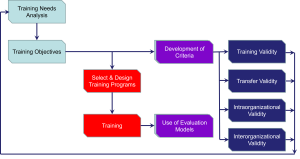
The model emphasizes the cyclical nature of effective training, where evaluation results inform future training needs analysis and program design decisions. It’s like a continuous improvement loop – you’re always getting better at getting better.
The model begins with training needs analysis, which serves as the foundation for all subsequent training activities. This is where organizations figure out what people actually need to learn, rather than just guessing or following the latest trends. Without adequate needs analysis, organizations risk developing training programs that address non-existent problems or fail to address actual performance deficiencies.
Following needs analysis, the model proceeds to training design and development, where specific learning objectives, content, and delivery methods are determined based on identified needs and available resources. This is where the magic happens – turning learning needs into actual learning experiences.
Training implementation involves the actual delivery of training content using selected methods and approaches. This is showtime! Effective implementation requires skilled trainers, appropriate facilities and equipment, and organizational support for both trainers and trainees.
Finally, training evaluation assesses the extent to which training objectives have been achieved and identifies areas for improvement in future training efforts. The cyclical nature of the model emphasizes that evaluation results should inform future needs analysis and program development activities. It’s all about learning from what worked and what didn’t.
Training Needs Analysis
Here’s where things get really practical. Training needs analysis represents the systematic process of determining whether training needs exist and, if so, what type of training is required to address identified deficiencies. Think of it as detective work – you’re gathering clues to solve the mystery of what people need to learn.
This analysis prevents organizations from implementing training programs based on assumptions rather than evidence. You know how sometimes you get mandatory training that seems completely irrelevant to your job? That’s what happens when someone skips the needs analysis step.
Organizational Analysis
Organizational analysis examines the organization’s short-term and long-term goals and compares these objectives to current performance levels. Where organizational performance falls short of established goals, training may serve as an intervention to improve results. But here’s the catch – you also need to consider available resources, including financial, human, and technological constraints that may influence training feasibility.
Organizational culture represents another critical consideration. Some organizational cultures may create obstacles to training effectiveness through lack of support for learning, resistance to change, or failure to reward improved performance. Training programs implemented in unsupportive organizational contexts are unlikely to achieve their intended objectives regardless of design quality. It’s like trying to plant a garden in poor soil – even the best seeds won’t grow.
Task Analysis
Task analysis involves examination of specific job requirements necessary for successful performance in each position. This analysis should utilize subject matter experts (SMEs) to gather comprehensive information about job-related competencies and performance standards. These are the people who actually do the job every day and know what it really takes to succeed.
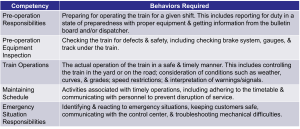
Task analysis examines how jobs are currently performed versus how they should be performed, identifying areas where performance deficiencies indicate training needs. Sometimes the gap between current and ideal performance reveals exactly what training is needed.

Person Analysis
Person analysis identifies which specific employees most need training based on individual performance data and development requirements. Organizations often utilize performance appraisal information to determine which employees would benefit most from training interventions. Customer feedback can also inform person analysis by identifying service providers who need additional development in interpersonal skills or technical competencies.
This isn’t about pointing fingers or finding fault – it’s about matching training resources with the people who can benefit most from them.
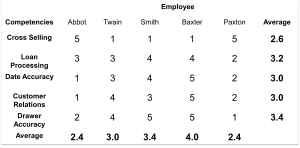
Demographic Analysis
Demographic analysis considers the demographic composition of the organization and assesses the training needs of various groups, including those covered under civil rights legislation. Different demographic groups may have distinct training requirements based on their backgrounds, experiences, and current capabilities.
Competency-Based Training
Competency-based training approaches identify the competencies a company wants all employees to have and then develop training programs around those competencies. Competencies represent sets of behaviors instrumental to accomplishing desired outcomes. This approach ensures consistency while focusing on behaviors that contribute to organizational effectiveness.
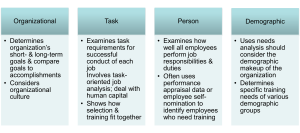
Media Attributions
- Training © Nick Youngson is licensed under a CC BY-SA (Attribution ShareAlike) license
- Goldstein & Ford’s Training Model adapted by Jay Brown
- Competencies for a Train Operator
- Seal of the United States Department of Education © U.S. Army Heraldry Directorate is licensed under a Public Domain license
- Training Needs Analysis
- Types of Training Needs Analysis
